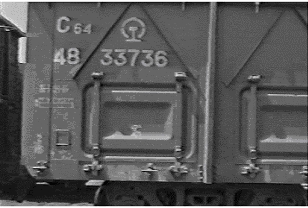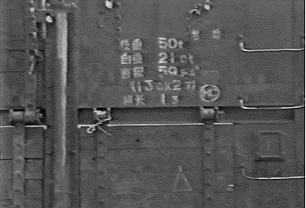Localization and Recognition of
Characters and Numbers on Moving Freight Trains
Frieght trains are the major transportation vehicles for goods such as steels,
oils, coal and other minerals in inland China. Usually freight trains come
to a destination, each of them with 20 to 50 cars (containers) of about 13
meter long, and loaded with various cargos. Because of the large amount of
cargoes going in and out in different places all around China, there are
cases when some of the cars go to wrong destinations, or the loads are not
correct, some of them with very expensive materials. Therefore it is extremely
important to verify the identity and to accurate weight the load of each
car when a freight train go in or out a (weighting) station. In most of the
cars of freight trains, two pieces of important information are labeled on
the car (Figure 1). On the head (or the center) of a car of the freight train,
the type and numbers of this car shows the identity of the car, while on
the tail of the car, important information such as maximum load, self-weight,
volume and length is used for accurate weight the load of the car.
In the past, trains move across the weighting station at the speed of about
20 kilometers per hour, and one or two human staffs tries to quickly read
and write down the information of the cars on a piece of paper, while the
load is being weighted (dynamically). However, there often cases that several
cars are not recorded, and the staffs get fatigued soon..
With the large amounts of requirements, we have developed an automatic
real-time vision system for frieght train management in large companies such
as steel, oil and coal factories. There are two modules in our system - Image
Capture Module and Character Recognition Module. In the automatic Image Capture
Module (with hardware and software), two cameras with different focal lengths
and fields of views were installed in a weighting station to capture the
side images of the passing trains. We used IR sensors and visual motion detection
techniques to capture the areas where types, numbers and other information
of each car. In the Character Recognition Module, we developed an effective
method for segmenting and recognizing the characters on freight trains automatically.
This algorithm consists of three components: image segmentation on gray-gradient
image, image analysis based on the domain knowledge and character segmentation/recognition
based on template matching, neural network and recognition feedback. Several
systems have been installed and tested in Chende, Hebei Province and northeastern
China.


Figure 1. Images of the (head and tail) areas of a car in a freight train
where characters and numbers are located. In the first image, the type (C64)
and number ( 48 33736) of the car is shown, while in the second image are
the maximum load (50 tons), self-weight (21.5 tons), volume (59) and length
(13 meters). This application raise challenging issues in text segmentation
and recognition due to various text locations, font sizes, dirt and damage
of the car, other structures on the surface and reflections.
Related Publications
Shaojie Wang, Zhigang Zhu, Dingji Shi,
Chiho Yu , Automatic segmentation and recognition of freight train characters,
Pattern Recognition and Artificial Intelligence, 1998, pp. 328-334
(in Chinese)
Shaojie Wang, Automatic localization and segmentation
of characters on freight trains, B.S. thesis, Department of Computer Science,
Tsinghua University, Beijing, 1997. (note: the fifth year of a undergraduate
student was devoted to a BS project for getting a BS degree at Tsinghua University)
Huiqiong Yang, Automatic character recognition using
template matching and neural network, B.S. thesis, Department of Computer
Science, Tsinghua University, Beijing, 1997.
Zhengkai Wang, Sensor design and installation for
text location and recognition on moving frieght trains, B.S. thesis, Department
of Computer Science, Tsinghua University, Beijing, 1997.
Collaborators:
Dingji Shi, Professor, Department of Computer Science and Technology,
Tsinghua University, Beijing
Chiho Yu, Associate Professor, Department of Computer
Science and Technology, Tsinghua University,
Beijing
Zhengwen Liu, Senior Engineer, Chende Automatic Equipment Company, Hebei
Province, China
Shaojie Wang, undergraduate student, Department of Computer Science
and Technology, Tsinghua University,
Beijing
Huiqiong Yang, undergraduate student, Department of Computer Science
and Technology, Tsinghua University,
Beijing
Zhengkai Wang, undergraduate student, Department of Computer Science
and Technology, Tsinghua University,
Beijing
Supported by
Chengde Automatic Equipment Company, Automatic Character
and Number Localization and Recognition for Managing Moving Freight Trains,
1996-1998, Co-PIs (Zhu, Shi and Yu)